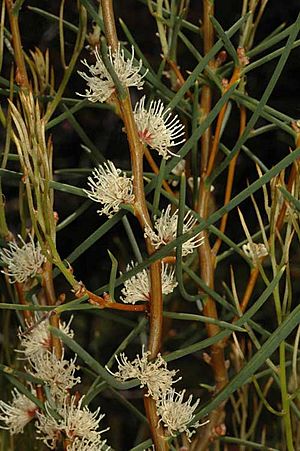Desert hakea facts for kids
Quick facts for kids Desert hakea |
|
|---|---|
 |
|
| Hakea mitchellii in the ANBG | |
| Scientific classification | |
| Genus: |
Hakea
|
| Species: |
mitchellii
|
 |
|
| Occurrence data from AVH | |
| Synonyms | |
|
Hakea muelleriana J.M.Black |
|
Hakea mitchellii, also known as desert hakea, is a type of shrub. It belongs to the Proteaceae plant family. This family includes many unique Australian plants.
What Does it Look Like?
Desert hakea is a bushy, rounded shrub. It can grow from 1 to 4 meters (about 3 to 13 feet) tall and wide. This plant does not have a special woody swelling at its base called a lignotuber. A lignotuber helps some plants regrow after a fire.
Its leaves can be different shapes. Some are round and thin, like a pencil. Others are flat and oval. They are usually 3.5 to 10 centimeters (about 1.4 to 4 inches) long. They can be 1 to 10 centimeters (about 0.4 to 4 inches) wide.
This plant has many pretty white or cream-colored flowers. They grow in clusters called racemes near the leaves. You can see these flowers between October and January. After flowering, the plant produces fruit. The fruit is shaped like an egg or an oval. It is about 1 to 2 centimeters (0.4 to 0.8 inches) long. It is also 0.5 to 1.5 centimeters (0.2 to 0.6 inches) wide. The fruit narrows down to a small point, like a beak.
How it Got its Name
The desert hakea was first officially described in 1856. A Swiss botanist named Carl Meissner gave it its scientific name. He published his description in a book called Prodromus Systematis Naturalis Regni Vegetabilis.
The very first plant used to describe the species was found near Pyramid Hill. This happened during an expedition in 1836. The explorer Thomas Livingston Mitchell collected it. The plant was named Hakea mitchellii to honor him.
Where it Grows
Desert hakea likes to grow in areas with specific plants. These areas are called mallee-heath vegetation. It prefers sandy soil that contains calcium carbonate. This type of soil is often found in dry, desert-like places.
You can mostly find this plant in South Australia. It grows on the Eyre, Yorke, and Fleurieu Peninsulas. It is also found on Kangaroo Island. Its range extends south of the Murray River to Naracoorte. You can also see it in western Victoria.

